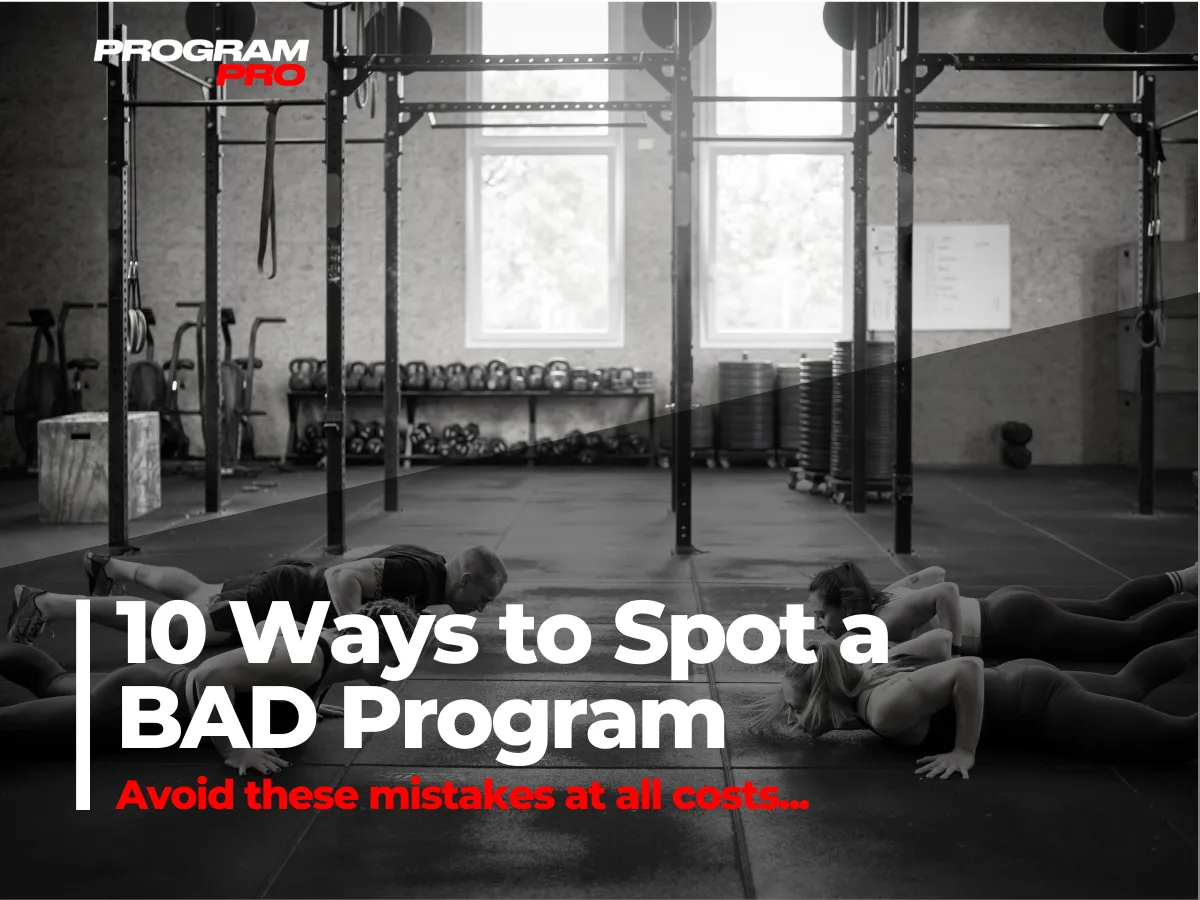
Program Pro Blog

10 Ways to Spot a BAD Program
Think about the best meal you've ever had.
Mine was schnitzel and potatoes on top of a mountain in Austria, where we took our mom for a surprise vacation to our Oma's hometown. We washed it down with a giant, ice-cold mug of beer after a 6-hour hike as we watched the sunset. I get teary-eyed just thinking about it.
Now think about the worst meal you've ever had.
Mine was at Applebee's. I can't remember what we ordered, but I remember it fucking sucked. Again, I get teary-eyed just thinking about it.
A great program is like a great meal. The food, atmosphere, and company all make for an unforgettable experience.
A bad program is like a bad meal. It tastes like crap.
As a trainer, you want to be a chef. You want to cook good meals.
If you suck at cooking, you'll lose friends (at least dinner guests).
If you suck at programming, you'll lose friends too (I mean clients).
The good part is it's easy to differentiate a good program from a bad one.
Here are 10 ways to spot a bad program (be sure to avoid these mistakes at all costs).
1. Olympic Weightlifting for Multiple Reps
Snatches and cleans for high-rep sets is silly, for a few reasons:
They're super technical. Weightlifting is actually really hard to do, which is why it's a sport. DUH!
Risk of injury goes way up. When fatigue kicks in, form breaks down. When form breaks down, so does your body.
They're meant to develop speed strength and power. Stick to 3-5 sets of 1-3 reps and limit them to 1-2 x per week.
2. Training Power-Specific Exercises Last
Think about it this way - no movement is innately explosive.
It's how you perform the movement that makes it explosive.
Consider this when you're about to program box jumps or med ball throws at the end of the session.
There's no sense in trying to develop power when you're fatigued.
As a general rule of thumb - perform the most important and complex exercises at the beginning of the workout, with the least important and complex exercises at the end of the session.
If you're going to include power-specific movements (ex. Olympic weightlifting, med ball throws, jumps) in your programs, put them at the beginning of the session (Block A).
Note: Power training towards the end of a training session can be applicable in some cases as you often need to express power in a fatigued state during competition. For example, an MMA fighter training to maintain knockout power in the fifth round.
3. High-Risk, Low-Reward Exercises
The trap many trainers fall into is the false assumption that all of your clients need to squat, bench, and deadlift with a barbell.
Not true.
The barbell is a great tool, but it isn't the only tool. Plus, like many other exercises, the risk to reward ratio isn't great for most people.
Take walking lunges for example. Good exercise. But are they a good fit for your 300lbs client with no training experience? Probably not.
Whenever you're about to program an exercise, ask yourself these two ROI's:
Return on investment - Does this bring my client closer to achieving their goal?
Risk of injury - Can my client perform this safely without messing themselves up?
If you answer yes to both of these questions, plug er in.
If no, don't do it. And if you do anyway, I will find you. Or hire Liam Neeson to.
4. No Notes
Taking notes after every session is the single most effective way to write better programs. And guess what...no one even does it!
If you want a simple and easy way to differentiate yourself from the competition (i.e. other trainers), take notes.
It doesn't have to be a novel, but when you have some point of reference when you whip open excel, you'll write way better programs.
Like, WAY better.
5. Too Many Exercises
“Essentialism is not about how to get more things done; it’s about how to get the right things done. It doesn’t mean just doing less for the sake of less either. It is about making the wisest possible investment of your time and energy in order to operate at our highest point of contribution by doing only what is essential.” - Greg McKeown, Essentialism
Similarly, great programming is not about how to get more exercises done; it's about how to get the right exercises done.
How many? It depends.
4-6 movements per session tends to be plenty for most people.
6. Too Much Variety
Variety is good. It keeps things interesting and helps your clients stay engaged.
Too much variety is bad. It might even be one of the reasons your program isn't working.
7. No Rest Guidelines
Hyper-focusing on rest periods can be counterproductive.
With that being said, you still need to include rest guidelines in your programs.
To find out the optimal rest periods for different training goals, refer to the Strength-Endurance Continuum below.

8. No Variety in Rep Ranges
A lot of trainers get stuck in the monotonous 3x10 or 3x5 and rarely step outside of these rep ranges.
This leaves potential results on the table as your clients aren't using all three strength training methods in their program.
Click the image below for some other examples of advanced sets for strength and muscle.

9. No Clear Focus
A bad program has no direction.
A good program has a clear focus.
That's why I think priority exercises are one of the best ways to improve your programming.
10. No Autoregulation
You want to write your programs in pencil, not ink.
Say your client has overhead presses in their program. But they tell you they got hit hard against the boards last night in hockey and messed up their shoulder.
Do you still do overhead presses? Or do you pivot and find a better alternative for today?
Learning how to adjust your programming on the fly is one of the most valuable skills you can have as a trainer.
Conclusion
Great programming is the foundation of a successful training business. When you write great programs, you get results. When you get results, you get referrals. When you get referrals, you build a reputation as the go-to trainer. When you build a reputation, you generate revenue.
With over 15 years experience in the gym, I've gone through a lot of trial and error and have tried a lot of different programs (both personally and with my clients).
After years of testing and plenty of results to back it up, I've come up with my ultimate 12-week training program. You can get it instantly for free here. All you need to do is enter your name and email.


